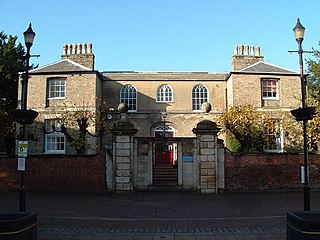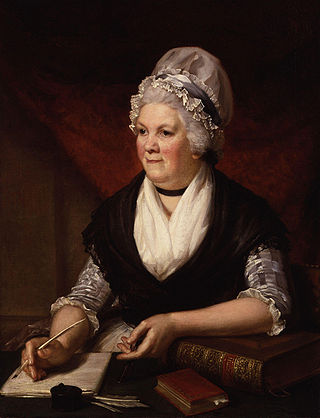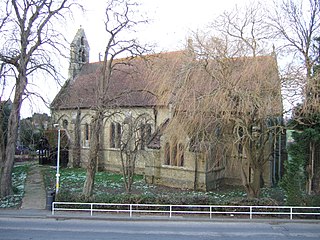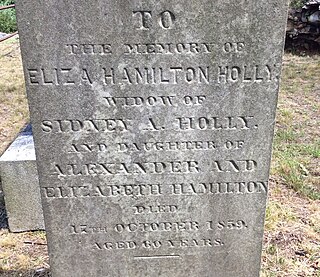Related Research Articles

Wisbech is a market town, inland port and civil parish in the Fenland district in Cambridgeshire, England. In 2011 it had a population of 31,573. The town lies in the far north-east of Cambridgeshire, bordering Norfolk and only 5 miles (8 km) south of Lincolnshire. The tidal River Nene running through the town is spanned by two road bridges. Wisbech is in the Isle of Ely and has been described as "the Capital of The Fens".

The Rev James Alexander Haldane aka Captain James Haldane was a Scottish independent church leader following an earlier life as a sea captain.

Elizabeth Ann Bayley Seton was a Catholic religious sister in the United States and an educator, known as a founder of the country's parochial school system. Born in New York and reared as an Episcopalian, she married and had five children with her husband William Seton. Two years after his death, she converted to Catholicism in 1805.

William Ellis was a British missionary and writer. He travelled through the Society Islands, Hawaiian Islands, and Madagascar, and wrote several books describing his experiences.

Wisbech Grammar School is an 11–18 co-educational, Church of England, private day school and sixth form in Wisbech, Isle of Ely, Cambridgeshire, England. Founded by the Guild of the Holy Trinity in 1379, it is one of the oldest schools in the country.

Wisbech Castle was a stone to motte-and-bailey castle built to fortify Wisbech on the orders of William I in 1072, it probably replaced an earlier timber and turf complex. The layout was probably oval in shape and size, on the line still marked by the Circus. The original design and layout is unknown. It was rebuilt in stone in 1087. The castle was reputedly destroyed in a flood in 1236. In the 15th century, repairs were becoming too much for the ageing structure, and a new building was started in 1478 under John Morton, Bishop of Ely. His successor, John Alcock, extended and completed the re-building and died in the Castle in 1500. Subsequent bishops also spent considerable sums on this new palace. The Bishop's Palace was built of brick with dressings of Ketton Stone, but its exact location is unknown.

Sarah Trimmer was an English writer and critic of 18th-century British children's literature, as well as an educational reformer. Her periodical, The Guardian of Education, helped to define the emerging genre by seriously reviewing children's literature for the first time; it also provided the first history of children's literature, establishing a canon of the early landmarks of the genre that scholars still use today. Trimmer's most popular children's book, Fabulous Histories, inspired numerous children's animal stories and remained in print for over a century.
The Rev Dan Taylor (1738–1816) was the founder of the New Connexion of General Baptists, a revivalist offshoot from the Arminian Baptist tradition, one of two main strands within the British Baptist movement.

Guyhirn is a village near the town of Wisbech in Cambridgeshire, England. It is on the northern bank, the North Brink, of the River Nene, at the junction of the A141 with the A47. The population is included in the civil parish of Wisbech St Mary. It is notable chiefly for the Chapel of Ease, a rare example of church architecture of the Interregnum (1649–1660), and as a key crossing point of the River Nene.

Margaret Ann Neve was the second validated supercentenarian after Geert Adriaans Boomgaard. Neve lived at Saint Peter Port on the island of Guernsey in the English Channel.

Wisbech St Mary is a village in the Fenland District of Cambridgeshire, England. It is 2 miles (3 km) west of the town of Wisbech. It lies between two roads, the B1169 and the A47. The population of the civil parish at the 2011 Census was 3,556.
Richard Wright was an English Unitarian minister, and the itinerant missionary of the Unitarian Fund, a missionary society established in 1806.

William Richards was a Welsh Baptist minister; he spent much of his life in King's Lynn, in Norfolk, and wrote a history of the town. His other publications included a Welsh-English dictionary.

Eliza Hamilton Holly was the seventh child and second daughter of Alexander Hamilton, one of the Founding Fathers of the United States, and his wife, Elizabeth Schuyler Hamilton.

Alderman Richard Young,, was a British merchant, shipowner and Liberal politician.
Lilian Ream, née Pratt was a photographer in Wisbech, Isle of Ely, Cambridgeshire. Her studios captured photographic images of Wisbech and the Fens for over 50 years.
Samuel Smith was an English photographer.
Jane Stuart, was a Quaker who lived and died in Wisbech, England. There is a long-standing tradition that she was a natural daughter of James II of England.

North Cambridgeshire Hospital is a healthcare facility in The Park, Wisbech, Cambridgeshire, England. It is managed by the Cambridgeshire and Peterborough NHS Foundation Trust.
References
- 1 2 3 4 5 6 W.F. Yeo (2011). "William Dawbarn: A Victorian Life" (PDF). University of Victoria. Archived from the original (PDF) on 17 August 2016. Retrieved 8 July 2016.
- 1 2 The Feminist Companion to Literature in English, ed. Virginia Blain, Patricia Clements and Isobel Grundy, (London: Batsford, 1990), p. 272.
- ↑ Elizabeth Dawbarn (1816). The young person's assistant in reading the Old Testament; in a series of letters from a mother to her children, relative to divine truth. p. 7.
- 1 2 Handbook of Women Biblical Interpreters, ed. Marion N. Taylor and Agnes Choi (Grand Rapids, MI: Baker Academic) Retrieved 8 July 2016.
- ↑ See, for example, the Index of Notable Baptists... before 1850 Retrieved 8 July 2016.